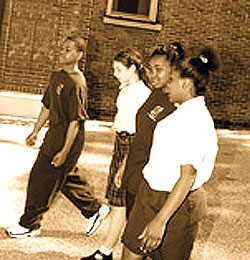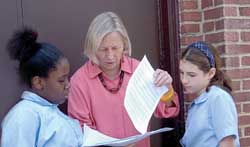By Jackie Powder
Photos by Bill McAllen

Working with students at two East Baltimore schools over the past few years, Maureen Maguire, MSN, RN, PNP, and Sara Groves, DrPH, MPH, MS, RN, CS, noticed a disturbing trend. An increasing number of the children they saw were overweight and obese—making them more susceptible to high blood pressure, asthma, and type 2 diabetes, and raising their risk of becoming overweight adults.
The assistant professors at the Hopkins School of Nursing decided to address the issue in a program they developed to serve 180 seventh and eighth graders at the two schools. The health insurer CareFirst provided $50,000 in grant money to launch the Children and Families in Motion program last fall at St. Bernardine’s School and The Crossroads School, a public middle school run by the Living Classrooms Foundation.
The goal of the year-long intervention was to teach children the importance of exercise in an area of Baltimore where there aren’t many backyards to play in, and where families can’t afford karate lessons.
“All the research says that except in extreme cases, what you need to do is increase children’s activity rather than limit foods,” says Maguire, who with Groves and nursing students has operated a health clinic for the past five years at St. Bernardine’s, a parochial school. Since 2002, the School of Nursing has offered health screenings at The Crossroads School.
“Obesity is considered a public health epidemic in the general population, and 25 percent of preschoolers and school age children are considered overweight,” Groves says.
With walking as the centerpiece of the program, each child received a pedometer to measure progress toward daily exercise goals. In regular visits to the two schools, Hopkins nursing students taught children about the benefits of exercise and helped students fill out their walking log books and chart their steps in graphs.
“I think they responded with a lot of real genuine interest,” says Crossroads principal Mark Conrad.

As the school year progressed, nursing students spent more time in classrooms talking to the children about the science of how fat is stored and calories are burned. They also measured students’ steps on a large United States map to see how far their walks took them.
In the program’s first year, Maguire and Groves said they encountered a number of unforeseen obstacles. Some kids didn’t think it was “cool” to wear pedometers. And in their food diaries, some children wrote that they ate five fast food meals a week, and no fresh fruit or vegetables.
“I really think we should be starting to do this in preschool because we know attitudes toward food form early in life,” Maguire says.
Despite some disappointments, some young people in the program got the message loud and clear. Maguire recalled that a nursing student went to a local play and recognized a student on stage who was a program participant. When the girl spotted the student nurse, she tugged on her shirt to reveal her pedometer.